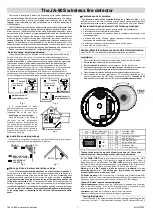
24
OPERATING INSTRUCTIONS
There should never be passengers on or around
any part of the vehicle. The vehicle is meant to
carry a driver only.
Use of this vehicle for purposes other than what
are defined by this manual could expose the
operator and/or others to serious injury or death.
SPEED:
Speed is one of the most important variables
leading to accidents. Driving too fast for the
conditions can cause you to lose control and
have an accident. Speed can also make a minor
accident worse. Driving head-on into a tree at
slow speed can cause injury and damage, but
driving into a tree at high speed can destroy the
vehicle and kill you.
Never drive too fast for the conditions. If there is
any doubt about how fast to drive, slow down.
When using heavy attachments (more than 1000
pounds) such as sprayers, top dressers, or
spreaders, etc., operating speeds should be
reduced.
TURNING:
Turning is another important variable leading to
accidents. Turning too sharply for the conditions
can cause the vehicle to lose traction and skid,
or even tip over.
Wet, sandy, and slippery surfaces make turning
more difficult and risky. The faster you are going,
the worse this situation becomes so, slow down
before turning.
During a sharp turn at higher speeds, the inside
rear wheel may lift off the ground. This is not a
flaw in the design, it happens with most four
wheel vehicles including passenger cars. If this
happens, you are turning too sharply for the
speed at which you are traveling. Slow down!
BRAKING:
It is good practice to slow down before
approaching an obstacle. This gives you extra
time to stop or turn away. Hitting an obstacle
can damage the vehicle and its contents. More
importantly, it can injure you.
Gross vehicle weight has a major impact on your
ability to stop and/or turn. Heavier loads and
heavier attachments make a vehicle harder to
stop or turn. The heavier the load, the longer it
takes to stop.
The braking characteristics also change with
attachments on the vehicle. Fast stops may cause
the wheels to lock up, which may affect the control
of the vehicle. Its a good idea to decrease the
vehicle speed with attachments.
Turf and pavement are much more slippery when
wet. It can take 2 to 4 times as long to stop on
wet surfaces as on dry surfaces.
If you drive through standing water deep enough
to get the brakes wet they will not work well until
they are dry. After driving through water you
should test the brakes to make sure they work
properly. If they do not, drive slowly in first gear
while putting light pressure on the brake pedal.
This will dry the brakes out.
NOTE: Heavy loads and turf conditions affect
your vehicle's brake performance and ability
to turn quickly without tipping over.
TIPOVERS:
The best way to prevent accidents involving the
Multi Pro® 1200 is through continuous
supervision and training of operators, and paying
constant attention to the area in which the vehicle
is being operated.
The best way for operators to prevent serious
injury or death to themselves or others is to
familiarize themselves with the proper operation
of the Muti Pro® 1200, to stay alert and to avoid
action or conditions which could result in an
accident. In the event of a tip over, the risk of
serious injury or even death will be reduced if the
operator and all involved follow the instructions
provided.
Use of this vehicle for purposes other than what
are defined by this manual could expose the
operator and/or others to serious injury or death.
The Multi Pro® 1200 is designed to provide safe
operation when common sense and good
judgement are exercised. An optional system for
additional protection is a Rollover Protection
Structure (ROPS). A ROPS system will reduce
the risk of serious or fatal injury in the unlikely
event of a tipover, although the system cannot
protect the operator from all possible injuries.
When using the ROPS system, a seat bel
t
should
always
be used.
Replace a damaged ROPS. Do not repair or
revise. Any alteration of ROPS must be approved
by manufacturer.
Содержание 41107-210000101
Страница 45: ...45 VEHICLE ELECTRICAL DIAGRAM 1703...
Страница 46: ...46 NOTES...
Страница 69: ...69 SPRAY SYSTEM FLOW DIAGRAM SPYSYT 1200 1...
Страница 77: ...77 NOTES...
Страница 78: ...78 NOTES...
Страница 79: ...79 NOTES...
















































